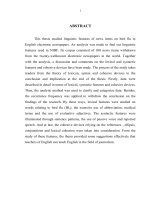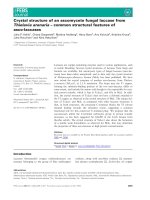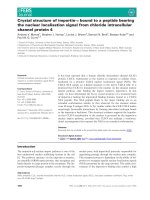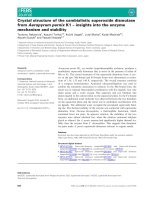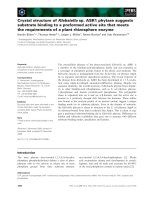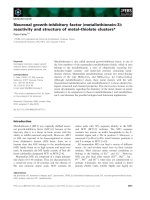typical structure of news articles
Bạn đang xem bản rút gọn của tài liệu. Xem và tải ngay bản đầy đủ của tài liệu tại đây (5.18 MB, 45 trang )
<span class="text_page_counter">Trang 1</span><div class="page_container" data-page="1">
<b>1. Introduction... 1</b>
<i><b>1.1. Rationale... 1</b></i>
<i><b>1.2. Aims of the study... 2</b></i>
<i><b>1.3. Limitations of the study... 2</b></i>
<i><b>1.4. Methods of the study... 2</b></i>
<i><b>1.5. Design of the study... 2</b></i>
<i><b>2. Typical structure of news articles...2</b></i>
<i><b>2.1. Typical structure of news articles on CNN...2</b></i>
<i><b>3. Messages and summaries...12</b></i>
<i><b>3.1. Messages and summaries of articles on CNN...12</b></i>
</div><span class="text_page_counter">Trang 2</span><div class="page_container" data-page="2"><b>4. Conclusion... 205. Appendix... 21</b>
</div><span class="text_page_counter">Trang 3</span><div class="page_container" data-page="3"><b>1. Introduction</b>
<i><b>1.1. Rationale</b></i>
Racial equality is one of the most fundamental rights of humans all around the world today. Racial equality happens when individuals are given legal, moral, and political rights. In the first half of the 20th century, it was especially difficult for African and Asian people to attain equality. Nevertheless, in modern societies, equality among races continues to become normative. In recent years, racial equality has become an essential part of laws generally ensuring that all citizens are treated equally in various areas of life, such as education, employment, health and many other fields.
In the modern history of the development of the racial equality, most of all human beings can not doubt the important role of journalism. Journalists collect information related to protests, interview excellent leaders of campaigns, reflect the injustice to Black and Asian people. Journalism educates millions of people about human rights, encourages them to fight for justice and contribute to racial equality in the world.
The United States is usually considered as one of the countries where always haveracial conflicts. American citizens and newspapers are two of the most significantfactors of the fight against racism which has taken place for many centuries. In2020, American events which attracted the attention of the worldwide media andresidents are George Floyd protests. They are a series of protests and civil unrestagainst police brutality and racism that began as part of international reactions dueto the murder of George Floyd, an African American man who was murdered duringan arrest after Derek Chauvin, a policeman, knelt on Floyd's neck for more thannine minutes and three other officers prevented passers-by from intervening. It isestimated that between 15 million and 26 million individuals had participated in thedemonstrations in the United States, making the protests the largest in Americanhistory. Journalism played a key role in calling on people to fight for justice forGeorge Floyd and racial equality. creating several debates on policing and racial
</div><span class="text_page_counter">Trang 4</span><div class="page_container" data-page="4">injustice that has led to numerous legislative proposals intended to combat systemic racism and police brutality.
As a consequence, the writer selected 10 articles related to George Floyd protests of many different newspapers in America and the UK and analyzed their structures and expressions. The writer expects that many outstanding contributions of journalism to one of the most principal events of this century will be discovered.
<i><b>1.2. Aims of the study</b></i>
Analyzing structures, messages and summary of divergent articles related to George Floyd protests of dissimilar newspapers in the US and UK, commenting personal opinions about these events and collecting valuable lessons related to journalism, racial equality and social movements,
<i><b>1.3. Limitations of the study</b></i>
Space limitation: in the United States Time limitation: from May 2020 to June 2020
<i><b>1.4. Methods of the study</b></i>
Analytical and synthesis method Logical method
Documentary research method Practical survey method
<i><b>1.5. Design of the study</b></i>
2. Typical structure of news articles 3. Messages and summaries 4. Comments for violence in protests
<i><b>2. Typical structure of news articles</b></i>
<i><b>2.1. Typical structure of news articles on CNN</b></i>
</div><span class="text_page_counter">Trang 5</span><div class="page_container" data-page="5"><i>Article 3: CNN Center in Atlanta damaged during protests.</i>
The first headline is considered to be short as its word counts are 14. Furthermore, the headline is also eye-catching when it uses emphatic words such as “tens of thousands”, largest”, “so far”. As a consequence, readers can understand obviously the impressive scale of protests. With 12 words, the second headline is shorter than the previous one. The writer used words such as “mount” and “multiple” to emphasize the skyrocketed troubles in several places and make readers realize the insecurity in the United States at that time. The final headline is the shortest when containing seven words. The writer summarizes all the most important points in the headline; namely, location (CNN Center in Atlanta) and event (damaged during protests). Additionally, these above headlines were written in present tense. Moreover, all headlines were written in third person.
<i>2.1.2. Leads</i>
<i>Article 1: Tens of thousands march in largest George Floyd protests so far in theUS.</i>
<i>Lead: Tens of thousands of people marched in cities and small towns across</i>
America in the largest demonstrations so far after George Floyd’s death. Who: Tens of thousands of American people.
What: Largest demonstrations.
Where: In cities and small towns across America. When: After the death of George Floyd. Why: George Floyd has died.
The lead does not contain how the event happened as this content.
<i>Article 2: Unrest mounts across multiple US cities over the death of George Floyd.Lead: Pain and anger over the death of George Floyd spilled over into multiple</i>
cities across the country hours after the former Minneapolis officer seen in video with his knee on Floyd’s neck was arrested and charged with murder.
What: Pain and anger over the death of George Floyd spilled over into multiplecities.
</div><span class="text_page_counter">Trang 6</span><div class="page_container" data-page="6">Where: Multiple cities.
When: After the former Minneapolis officer seen in video with his knee on Floyd’s neck was arrested and charged with murder.
Why: Minneapolis officer with his knee on Floyd’s neck.
The “Who” and “How” components are not comprised in the lead paragraph.
<i>Article 3: CNN Center in Atlanta damaged during protests.</i>
<i>Lead: The front of CNN Center in Atlanta was the scene of violent protests on</i>
Friday evening that resulted in damage to the front of the building and inside. What: Damage to the front of the building CNN Center and inside. Where: CNN Center in Atlanta.
When: Friday evening. Why: Violent protests.
“Who” element does not exhibit in the lead paragraph. The happening was complicated enough that the writer devoted from the fourth to seventh paragraphs to explain it.
In addition, all above lead paragraphs were written in third person perspective. It will make readers think that news is reported objectively and professionally.
<i>2.1.3. Bodies</i>
<i>Article 1: Tens of thousands march in largest George Floyd protests so far in the US</i>
The main section includes lots of important information about what happened and is six parts long. The most foremost information about the event goes first with some paragraphs that describe specifically many demonstrators who joined in protests in the capital city and many other cities in America as well as attending a memorial service of George Floyd. Following parts explain the background information that is relevant to the event; namely, the anger of individuals, policing changes and others. The article contains many quotes from protesters, authorities and policemen,
<i>Article 2: Unrest mounts across multiple US cities over the death of George Floyd</i>
The body contains 5 long parts that focus on different topics of the event. The firstand foremost details were put at the beginning and they give readers an overall of
</div><span class="text_page_counter">Trang 7</span><div class="page_container" data-page="7">the violent status. Succeeding parts pay attention to the anger of George Floyd’s family, the doubts surrounding reasons of death of Floyd, latest news of protests and tension in Minneapolis. A lot of statements of demonstrators and relatives of Floyd were added in the article.
<i>Article 3: CNN Center in Atlanta damaged during protests.</i>
The body describes violent behaviors of protesters in the timeline. At the beginning, the protests had started as peaceful. However, some hours later, citizens destroyed many infrastructures of CNN Center and vehicles of policemen. Journalists quoted criticism of the mayor for the destruction.
<i>2.1.4. Endings</i>
<i>Article 1: Tens of thousands march in largest George Floyd protests so far in theUS.</i>
The ending of the first articles added the least indispensable information specifically two officers were suspended after they allegedly pushed a protester to the ground.
<i>Article 2: Unrest mounts across multiple US cities over the death of George Floyd.</i>
The ending of thehe second article quoted the condemnation of the Minneapolis mayor.
<i>Article 3: CNN Center in Atlanta damaged during protests.</i>
The ending of the final article focuses on a CNN crew was arrested while giving a live report morning.
<i><b>2.2. Typical structure of news articles on USAToday</b></i>
<i>2.2.1. Headline</i>
<i>Article 1: Americans’ perceptions of police drop significantly in one week asprotests continue, survey finds</i>
<i>Article 2: George Floyd protests in Minneapolis: Police use tear gas, smokegrenades; more than two dozen arrested</i>
The range of words of two articles are 14 and 16 respectively. The first article uses“significantly” to emphasize the plummeted perceptions of citizens while the other
</div><span class="text_page_counter">Trang 8</span><div class="page_container" data-page="8">reports some highlights of protests, including tear gas, smoke grenades and two dozen people were arrested. Overall, headlines summarize main points of articles and attract the concern of readers. Besides, these above titles were written in present tense, past tense and in third person perspective. Non-essential words such as “the'' and “a” are eliminated.
<i>2.2.2. Leads</i>
<i>Article 1: Americans' perceptions of police drop significantly in one week asprotests continue, survey finds</i>
<i>Lead: The perception of police by white Americans has dropped by double digits in</i>
just one week, as police continue to target peaceful protesters, bystanders and journalists amid nationwide demonstrations focusing on systemic racism facing black Americans.
Who: White Americans
What: Perception of police by white Americans has dropped
Why: Police continue to target peaceful protesters, bystanders and journalists How: Double digits in just one week
Locations and dates in the survey are not included in the lead paragraph.
<i>Article 2: George Floyd protests in Minneapolis: Police use tear gas, smokegrenades; more than two dozen arrested</i>
<i>Lead: Police used tear gas, smoke grenades and nonlethal projectiles Saturday night</i>
in a coordinated effort to break up groups gathering after the start of the Twin Cities' curfew, aimed at preventing another night of violent protests after days of unrest following the death of George Floyd.
Who: Police
What: Police used tear gas, smoke grenades and nonlethal projectiles Where: Twin Cities
When: Saturday night
</div><span class="text_page_counter">Trang 9</span><div class="page_container" data-page="9">Why: Break up groups gathering after the start of the Twin Cities' curfew, aimed at preventing another night of violent protests after days of unrest following the death of George Floyd.
The detailed information about how the event happened is not comprised in the lead paragraph.
<i>2.2.3. Bodies</i>
<i>Article 1: Americans' perceptions of police drop significantly in one week asprotests continue, survey finds</i>
The body consists of several different paragraphs with dissimilar lengths. The first half of the article presents in detail the most crucial results of a new survey from the Democracy Fund + UCLA Nationscape Project. Particularly, impressions of police officers of white Americans, black Americans, Asian and Pacific Islanders plunged obviously. The second half of the article expresses the reason for protests, the unrest across the United States and conflicts between policemen and demonstrators as well as the reaction of the Trump administration. Journalists use numbers in the survey and comments of the research director to rocket the convincement of the information.
<i>Article 2: George Floyd protests in Minneapolis: Police use tear gas, smokegrenades; more than two dozen arrested</i>
The body contains 12 parts that focus on different aspects. The outstanding information related to the efforts of authorities to maintain the peace and against violent protests is presented in the first part. In addition, following parts indicate tear gas, smoke bombs and explosions, curfew falls, officials walk back claims about out-of-state arrests, volunteers offer help, recommendation of the district representative and many other various issues. Writers also encompass statements of local authorities and opinions of social workers, normal residents.
<i>2.2.4. Endings</i>
<i>Article 1: Americans' perceptions of police drop significantly in one week asprotests continue, survey finds.</i>
</div><span class="text_page_counter">Trang 10</span><div class="page_container" data-page="10">The ending of the first article supplies surrounding information about violent behaviors journalists had to face in the process of collecting news.
<i>Article 2: George Floyd protests in Minneapolis: Police use tear gas, smokegrenades; more than two dozen arrested.</i>
The ending of the second article includes a link for more information of criminal complaints in the George Floyd case.
<i><b>2.3. Typical structure of news articles on The Guardian</b></i>
<i>2.3.1. Headline</i>
<i>Article 1: No masks, no water: New York protesters held in ‘abysmal’ conditions,experts say</i>
<i>Article 2: George Floyd killing: peaceful protests sweep America as calls for racialjustice reach new heights</i>
<i>Article 3: George Floyd: Donald Trump under fire as violence flares acrossAmerica</i>
<i>Article 4: George Floyd protesters condemn 'opportunistic' looting and violenceArticle 5: What the George Floyd protests have achieved in just two weeks</i>
Word counts five articles are 13, 15, 11, 8 and 11 respectively. As an effect, the second one has the longest title and the fourth headline is the shortest. First three articles share the same writing style when reporting the most noticeable details after colons. Alternatively, the final headline is a question to stimulate the curiosity of readers. Different from them, the fourth article maintains a traditional title. All things considered, the above titles give readers an outline of pivotal points of events. All of them were written in present tense and perfect present tense. Moreover, journalists wrote from the third person perspective.
<i>2.3.2. Leads</i>
<i>Article 1: No masks, no water: New York protesters held in ‘abysmal’ conditions,experts say.</i>
<i>Lead: More than 2000 people have been arrested in the city and the police treatment</i>
of those detained is emboldening people.
</div><span class="text_page_counter">Trang 23</span><div class="page_container" data-page="23">They also need to be aware of their responsibility to support meaningful protests for a better future.
<b>4. Conclusion </b>
George Floyd protests are considered as the broadest protests in American history. They attracted the attention of the press and millions of people on the world, contributed to many worthy policy changes and made calls for the racial justice reach new heights. Hundreds of articles were written about protests. As a result, the writer of this assignment chose ten related articles on famous American and British newspapers including CNN, USAToday and The Guardian to analyze in detail the structure of articles. Furthermore, the writer also points out messages and summaries of each articles. Moreover, the author presents the personal opinion about demonstrations.
George Floyd protest is one of the most important events in 2020. Articles written by professional journalists in America and the United Kingdom are so excellent. The writer of this assignment learned a lot of knowledge that relate to the structure of a news article, the way to summary an article and to express the message through words. They are definitely valuable experiences for any students who study the journalism.
<b>5. Appendix</b>
<i><b>1) Nicole Chavez, Ray Sanchez and Madeline Holcombe. (2020). Tens of thousands march in largest George Floyd protests so far in the US </b></i>
( QOaipCQ)
<b>Tens of thousands march in largest George Floyd protests so far in the US</b>
Tens of thousands of people marched in cities and small towns across America in the largest demonstrations so far after George Floyd’s death.
Protesters poured onto the streets of the nation’s capital to demand an end to police brutality and racial injustice. They braved the heat, wore masks and chanted in unison at the Lincoln Memorial and near the White House. “I don’t care if I lose my life if that means my nieces and my nephews won’t have to deal with someone invalidating them because of the color of their skin,” said
</div>
